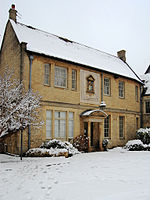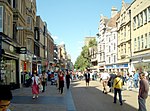Northgate Hall

The Northgate Hall at the present 18 St Michael's Street, Oxford, England is owned by Oxford City Council. It was built in 1870–1 as a United Methodist Free Church chapel and schools to the designs of J. C. Curtis. Until the twentieth century it was confusingly described as being in New Inn Hall Street, the former name for what is now St Michael's Street. It is a Grade II Listed Building.The following report in Jackson's Oxford Journal of 15 October 1870 describes the new building: METHODIST FREE CHURCH, NEW INN HALL STREET [now St Michael's Street]. The congregation at present assembling in the Old Quaker's Chapel have a new Chapel in course of erection in New Inn Hall-street. The site is on that portion of the old city walls whereon stables were lately built, and in digging for the foundation the workmen came upon one of the bastions in a state of perfect preservation, but part of it had to be removed for the new erection. The building will be in the Grecian Doric style of architecture, from the designs of Mr. J. C. Curtis, Mr. Dover being entrusted with the contract. It is to be 52 feet in length and 48 feet in breadth, comprising two storeys, on the basement being the schools, and above the chapel, with the chapel-keeper's residence and other necessary offices. The chapel will accommodate about 500 people, and the contractor anticipates finishing the work before March next, although we believe the stipulated time is the last day in January. The site is held on a lease from the Corporation for 75 years, and the total cost, inclusive of the lease, is estimated at £1500. It was renamed the Northgate Hall in the late 1920s. Following Methodist Union in 1932 the building was no longer needed by the Methodists as the Wesley Memorial Church was only about 100 m away. From 1933 until the summer of 1989 the Northgate Hall served as the base for the Oxford Inter-Collegiate Christian Union (OICCU). In 1991 Sir Ian McKellen opened the Oxford Lesbian and Gay Community Centre at the Northgate Hall, and it remained here until 2004. Also from 1991 it was the home of the Gatehouse, a drop-in centre for homeless people set up by churches in the centre of Oxford. In 2001, it suffered damage from a fire.The Gatehouse remained in part of the building, but in January 2011 the City Council issued a statement that they were giving it notice to move out, citing financial pressures and the fact that the building was underoccupied as users of other parts of the building had left. Gatehouse moved to new premises in 2012.From 2013 to 2020 the former hall was occupied by the Bill's Oxford restaurant. The lease of the whole building was sold in 2022, and in November that year a planning application was approved for change of use from a restaurant back to its original function as a chapel and church hall.
Excerpt from the Wikipedia article Northgate Hall (License: CC BY-SA 3.0, Authors, Images).Northgate Hall
St Michael's Street, Oxford City Centre
Geographical coordinates (GPS) Address Website External links Nearby Places Show on map
Geographical coordinates (GPS)
| Latitude | Longitude |
|---|---|
| N 51.7535 ° | E -1.2594 ° |
Address
Bill's
St Michael's Street 18
OX1 2DU Oxford, City Centre
England, United Kingdom
Open on Google Maps










